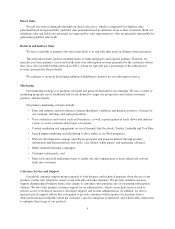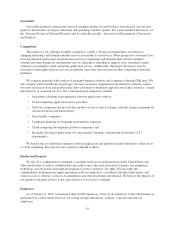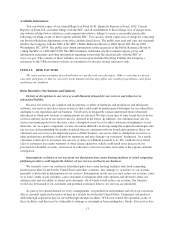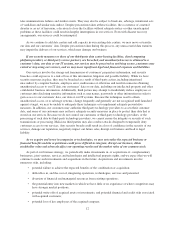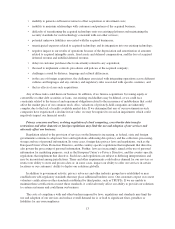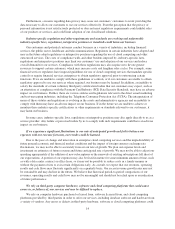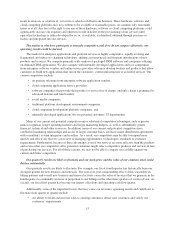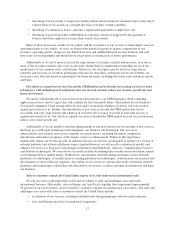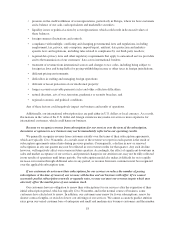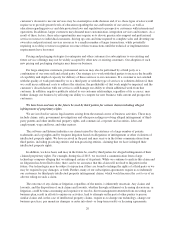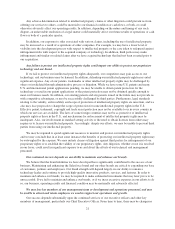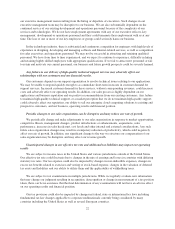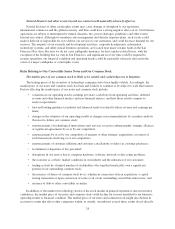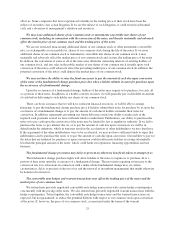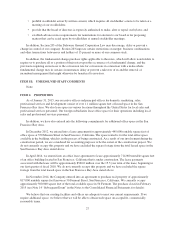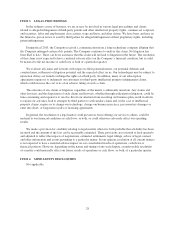Salesforce.com 2015 Annual Report Download - page 25
Download and view the complete annual report
Please find page 25 of the 2015 Salesforce.com annual report below. You can navigate through the pages in the report by either clicking on the pages listed below, or by using the keyword search tool below to find specific information within the annual report.of multi-year subscription contracts. Our attrition rates may increase or fluctuate as a result of a number of
factors, including customer dissatisfaction with our services, customers’ spending levels, decreases in the number
of users at our customers, pricing changes and deteriorating general economic conditions.
Our future success also depends in part on our ability to sell additional features and services, more
subscriptions or enhanced editions of our services to our current customers. This may also require increasingly
sophisticated and costly sales efforts that are targeted at senior management. Similarly, the rate at which our
customers purchase new or enhanced services depends on a number of factors, including general economic
conditions and that our customers do not react negatively to any price changes related to these additional features
and services. If our efforts to upsell to our customers are not successful our business may suffer.
If the market for our technology delivery model and enterprise cloud computing services develops more
slowly than we expect, our business could be harmed.
Our success depends on the willingness of third-party developers to build applications that are
complementary to our services. Without the development of these applications, both current and potential
customers may not find our services sufficiently attractive. In addition, for those customers who authorize a
third-party technology partner access to their data, we do not provide any warranty related to the functionality,
security and integrity of the data transmission or processing. Despite contract provisions to protect us, customers
may look to us to support and provide warranties for the third-party applications, which may expose us to
potential claims, liabilities and obligations for applications we did not develop or sell, all of which could harm
our business.
Supporting our existing and growing customer base could strain our personnel resources and
infrastructure, and if we are unable to scale our operations and increase productivity, we may not be able to
successfully implement our business plan.
We continue to experience significant growth in our customer base and personnel, which has placed a strain
on our management, administrative, operational and financial infrastructure. We anticipate that additional
investments in our internal infrastructure, data center capacity, research, customer support and development, and
real estate spending will be required to scale our operations and increase productivity, to address the needs of our
customers, to further develop and enhance our services, to expand into new geographic areas, and to scale with
our overall growth. If we fail to successfully scale our operations and increase productivity, we will be unable to
execute our business plan.
We regularly upgrade or replace our various software systems. If the implementations of these new
applications are delayed, or if we encounter unforeseen problems with our new systems or in migrating away
from our existing applications and systems, our operations and our ability to manage our business could be
negatively impacted.
Our success will depend in part upon the ability of our senior management to manage our projected growth
effectively. To do so, we must continue to increase the productivity of our existing employees and to hire, train
and manage new employees as needed. To manage the expected domestic and international growth of our
operations and personnel, we will need to continue to improve our operational, financial and management
controls, our reporting systems and procedures, and our utilization of real estate. The additional investments we
are making will increase our cost base, which will make it more difficult for us to offset any future revenue
shortfalls by reducing expenses in the short term.
As more of our sales efforts are targeted at larger enterprise customers, our sales cycle may become more
time-consuming and expensive, we may encounter pricing pressure and implementation and customization
challenges, and we may have to delay revenue recognition for some complex transactions, all of which could
harm our business and operating results.
As we target more of our sales efforts at larger enterprise customers, we may face greater costs, longer sales
cycles, greater competition and less predictability in completing some of our sales. In this market segment, the
19


